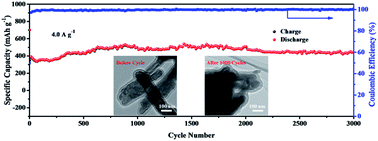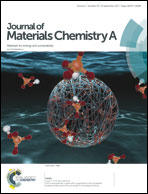Na–Mn–O@C yolk–shell nanorods as an ultrahigh electrochemical performance anode for lithium ion batteries†
Abstract
A considerable amount of intensive research has been made towards efficient energy storage, particularly regarding rechargeable lithium-ion batteries (LIBs). However, there are still huge limitations to the applications of state-of-the-art LIBs, including their inadequate durability, safety concerns and high costs, and so they cannot meet the ever-growing demand for portable electronic devices and power batteries. Therefore, designing viable LIBs with high cost efficiency and performance through integration of new alternative electrode materials possessing well-controlled nanostructures is critical. Herein, we rationally design a facile and effective method to construct Na0.55Mn2O4·1.5H2O@C (SMOH@C) yolk–shell nanorods which integrate a one side internal void with the outer carbon shell framework. By virtue of such a yolk–shell structure and composition, as an anode material, the as-built electrode endows LIBs with attractive electrochemical performances including a high specific reversible capacity (750 mA h g−1 at 0.1 A g−1), an excellent rate and superior long term cycling capability (448 mA h g−1 capacity retention after 3000 cycles at 4.0 A g−1). This unique structure design strategy paves the way to produce new anode materials with superior performances for next-generation LIBs.

- This article is part of the themed collection: 2017 Journal of Materials Chemistry A HOT Papers


 Please wait while we load your content...
Please wait while we load your content...